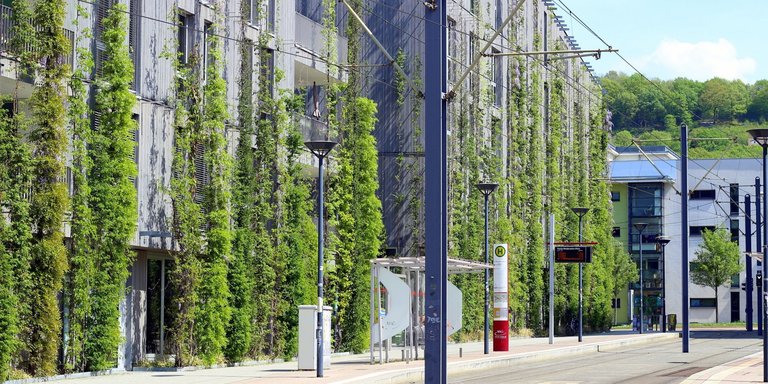Four out of five cities worldwide are exposed to extreme heat or flooding, according to a study by the Carbon Disclosure Project organisation. Climate change is likely to exacerbate the situation further. But municipalities are not helpless: nature-based solutions and forward planning will make cities more climate resilient and environmentally sustainable. Promising adaptation strategies were explained by experts at the Dialogue Forum special organised by the Munich Re Foundation on the occasion of the Munich Climate Autumn 2022.
According to the Carbon Disclosure Project, cities that put their citizens at the centre of their climate protection plans have an advantage. This can mean responding to the needs of particularly vulnerable groups or generally involving the population in the planning process. Silvia Gonzalez from the Munich-based environmental organisation Green City e.V. is convinced that "everyone can contribute to greater climate resilience, and property owners in particular have a responsibility.” However, the path to the green city of the future is not that easy for Munich, as landscape architect and urban planner Stefanie Jühling explained: "Munich is the most heavily sealed city in Germany. According to the Department for Climate and Environmental Protection, 44 per cent of the city's area is built up with roads or buildings.” The result: on hot days the air shimmers over the asphalt, heavy rain overloads the sewage system.
Munich is still lucky in this respect because the city is not one of the high-risk areas, as city building councillor Prof. Elisabeth Merk made clear. "The greatest danger I see for Munich is not so much extreme events, but rather the inertia that we are tackling the conversion into a green city too slowly." In the case of new buildings, it is still relatively easy to change the levers towards more sustainability, but these only account for about one per cent of the buildings in the city. The leverage therefore lies in the transformation of existing buildings and neighbourhoods, for which, however, relief strategies are lacking. One does not always have to think on a very large scale. "I am a friend of the small building blocks," Merk confessed. Cities are an important part of the solution, she said, because the ecological footprint is only half as large as in the countryside due to the lower per capita land consumption. Merk sees it as an important task to forge new alliances for climate adaptation and climate protection, and not just to discuss them within their own professional circles. Or, as Jühling put it: "We have to interlink the different departments such as urban planning, civil engineering or horticulture more closely."
Stephan Pauleit, Professor of Strategy and Management of Landscape Development at the Technical University of Munich, has a similar view: "We need to ensure that green ideas are considered from the outset and that climate change adaptation goals are comprehensively integrated into urban and sectoral planning across all departments." The goal, he said, must be to develop an efficient and high-quality green infrastructure and to redistribute contested areas in public space such as roads. "This also includes the infrastructure below the streets, where a proliferation of supply and disposal lines as well as underground shafts has developed over the past more than 100 years." Without a mobility turnaround, however, Pauleit says, climate change adaptation through green infrastructure will not succeed.
Creating oases without compulsive consumption
More green in public spaces is right up urban planner Jühling's alley: "Fewer cars means more space for trees and benches." This could be implemented quickly to create small oases in the city without compulsive consumption. Trees, added Green City expert Gonzalez, are an unbeatable element for climate adaptation by providing biodiversity, keeping the air clean and contributing to noise reduction. "We need a tree action plan, if necessary also at the expense of car traffic," she demanded. And one should not get bogged down in details or speculate on the jack of all trades device, she said, but simply get started.
Small changes can involve green roofs, water retention basins or infiltration areas such as tree trenches, for example. "Building is expensive," Jühling admitted. But building owners are certainly amenable to the ideas of a greener city. Projects in which non-profit housing associations bear the construction costs are at an advantage. Here, it is easier to take green infrastructure into account in the various planning phases - from the initial informal considerations to the legal stipulations in the development plan. "In the case of a courtyard with numerous owners, this is much more laborious," Pauleit pointed out. Especially since very few building owners know that the city of Munich has set up subsidy programmes for green inner courtyards, façades or roofs, Gonzalez added.
The sponge city principle goes hand in hand with more green spaces: rainwater should not simply disappear into the sewage system, but should seep away or be retained on site. "This is urgently needed because trees need sufficient root space and water," Pauleit explained.
Building law versus climate adaptation
City building councillor Merk made it clear that conflicts of interest are bound to arise. "There are a number of committees with different political members and different goals, so decision-making in the city council is not always easy," she knows from experience. In addition, one cannot simply give climate adaptation top priority, but must adhere to applicable regulations and building law. Some things, such as the residential property law or the parking space ordinance, cannot be changed by municipalities like Munich. "We need stronger control at the higher legislative level," she demanded.
So urban society can contribute in many ways to creating more green spaces. But this will only work if climate adaptation and climate protection become a focus of urban planning and all stakeholders - residents, homeowners and businesses - are brought on board. Merk is convinced that "some positive developments have already taken place in the past decades, otherwise the city would look different today".
A look at Copenhagen shows what else is possible in the future. There, urban planning was geared towards making the city greener in consensus with the population, and the expansion of climate-friendly mobility was pushed forward. With success: the European Commission awarded Copenhagen the title of European Capital of the Environment in 2014. The Danes are obviously doing a lot right. It's high time that cities like Munich learn from them.
03 November 2022







